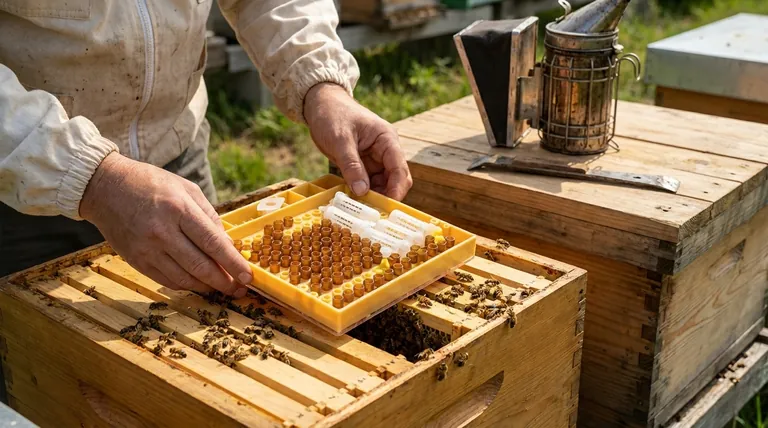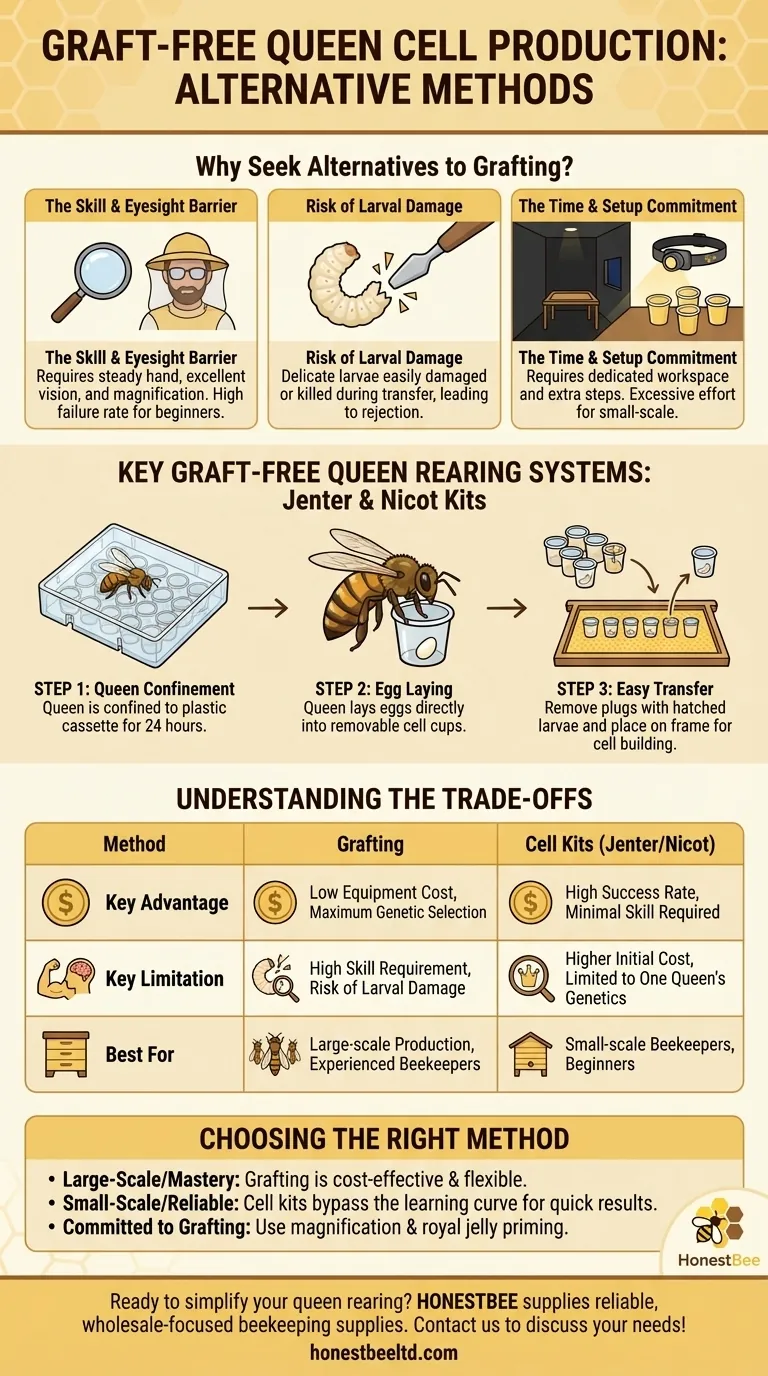For beekeepers seeking to raise queens without grafting, the primary alternatives are queen-rearing kit systems. The most common of these are the Jenter and Nicot systems, which allow you to produce queen cells by encouraging the queen to lay eggs directly into removable cell cups, completely bypassing the need for manual larval transfer.
The central challenge of raising queens is ensuring a delicate, day-old larva is successfully transferred and accepted by nurse bees. While traditional grafting requires manual dexterity and skill, modern kit systems eliminate this step, making queen rearing more accessible for small-scale beekeepers.

Why Seek Alternatives to Grafting?
Grafting is a powerful technique, but it presents several common barriers, particularly for hobbyists or those new to queen rearing. Understanding these challenges clarifies the appeal of graft-free methods.
The Skill and Eyesight Barrier
Grafting involves transferring a minuscule, C-shaped larva from its wax cell into an artificial queen cup. This requires a steady hand, excellent eyesight, and often magnification, especially for beekeepers over 40. The process is a learned skill that requires significant practice to achieve high acceptance rates.
Risk of Larval Damage
The larvae are incredibly fragile. An unsteady hand or improper technique can easily damage or kill them during transfer. Even if the larva survives, the stress of a clumsy transfer can lead to rejection by the nurse bees in the cell-builder colony.
The Time and Setup Commitment
Proper grafting requires a dedicated setup, often involving a dark room, headlamp, and other tools. Priming the cells with royal jelly can improve success, but it adds another step. For a beekeeper only looking to raise a handful of queens, this can feel like an excessive amount of work.
Key Graft-Free Queen Rearing Systems
Cell kit systems were designed specifically to overcome the challenges of grafting. They work by tricking the queen into laying eggs in a place that makes the future queen cells easy to manage.
The Jenter and Nicot Systems
The Jenter and Nicot kits are the two most popular systems on the market. While they differ slightly in design, their core principle is identical. Both use a plastic box or cassette that mimics a small section of honeycomb.
How These Systems Work
The process involves confining the queen on this plastic grid for a short period (usually 24 hours). She lays her eggs directly into the small, removable plastic cell plugs or cups that form the base of the grid.
Once the queen has laid the eggs, she is released. The beekeeper waits three days for the eggs to hatch into larvae. At this point, you can simply remove the individual plugs—each containing a perfect, untouched larva—and place them onto a frame designed to hold them. This frame is then put into a queenless cell-builder colony to be raised into queen cells.
Understanding the Trade-offs
Neither method is universally superior; the best choice depends on your goals and resources.
Grafting: High Skill, Low Cost
The primary advantage of grafting is its minimal equipment cost. All you need are cell cups and a grafting tool. It offers beekeepers maximum control, allowing them to select larvae from any frame and any colony.
The downside is the steep learning curve and the physical requirements for success. Failure rates can be high initially, causing frustration and wasted time.
Cell Kits: Low Skill, Higher Cost
The primary advantage of Jenter or Nicot systems is their accessibility. They virtually eliminate the chance of damaging larvae and remove the need for a surgeon's steady hand, leading to higher success rates for beginners.
The downside is the initial investment in the kit. Furthermore, success depends on getting the queen to accept the plastic cassette and lay in it, which can sometimes be a challenge. You are also limited to the genetics of the single queen you confine.
Choosing the Right Method for Your Apiary
The best method depends entirely on your scale, budget, and personal preference.
- If your primary focus is large-scale production or mastering the craft: Learning to graft is the most cost-effective and flexible skill for raising a high volume of queens from diverse genetic stock.
- If your primary focus is raising a few high-quality queens reliably: Investing in a Jenter or Nicot kit is an excellent way to bypass the grafting learning curve and achieve consistent results quickly.
- If you are committed to grafting but struggling: Ensure you are using magnification (3x-4x), a bright headlamp, and consider priming the cell cups with diluted royal jelly to improve acceptance.
Ultimately, your goal is to produce healthy, well-fed queens, and either path can lead to that success.
Summary Table:
| Method | Key Advantage | Key Limitation | Best For |
|---|---|---|---|
| Grafting | Low equipment cost, maximum genetic selection | High skill requirement, risk of larval damage | Large-scale production, experienced beekeepers |
| Jenter/Nicot Kits | High success rate, minimal skill required | Higher initial cost, limited to one queen's genetics | Small-scale beekeepers, beginners |
Ready to simplify your queen rearing? HONESTBEE supplies commercial apiaries and beekeeping equipment distributors with reliable, wholesale-focused beekeeping supplies. Whether you're interested in exploring queen-rearing kits or other essential equipment, our experts can help you find the right solution for your operation. Contact us today to discuss your needs and benefit from our wholesale expertise!
Visual Guide

Related Products
- Nicot Queen Rearing Kit for Beekeeping and Grafting in Nicot System
- No Grafting Queen Rearing Kit: System for Royal Jelly Production and Queen Rearing
- Jenter Queen Rearing Kit Complete Set for Bee Breeding
- Brown Nicot Queen Cell Cups for Breeding Queen Bees Beekeeping
- JZBZ Langstroth Queen Rearing Frame for Beekeeping
People Also Ask
- What is essential for successful queen rearing in beekeeping? Master Genetics & Boost Your Apiary's Health
- Can anyone use Queen Rearing with JZBZ? A Beginner-Friendly System for All Beekeepers
- What are the methods of queen rearing? Master Grafting, Direct Lay & More
- What should be done once eggs are present in the comb box? A Guide to Maximizing Queen Rearing Success
- What happens if a larva is grafted too late? Avoid Scrub Queens and Failed Rearing










